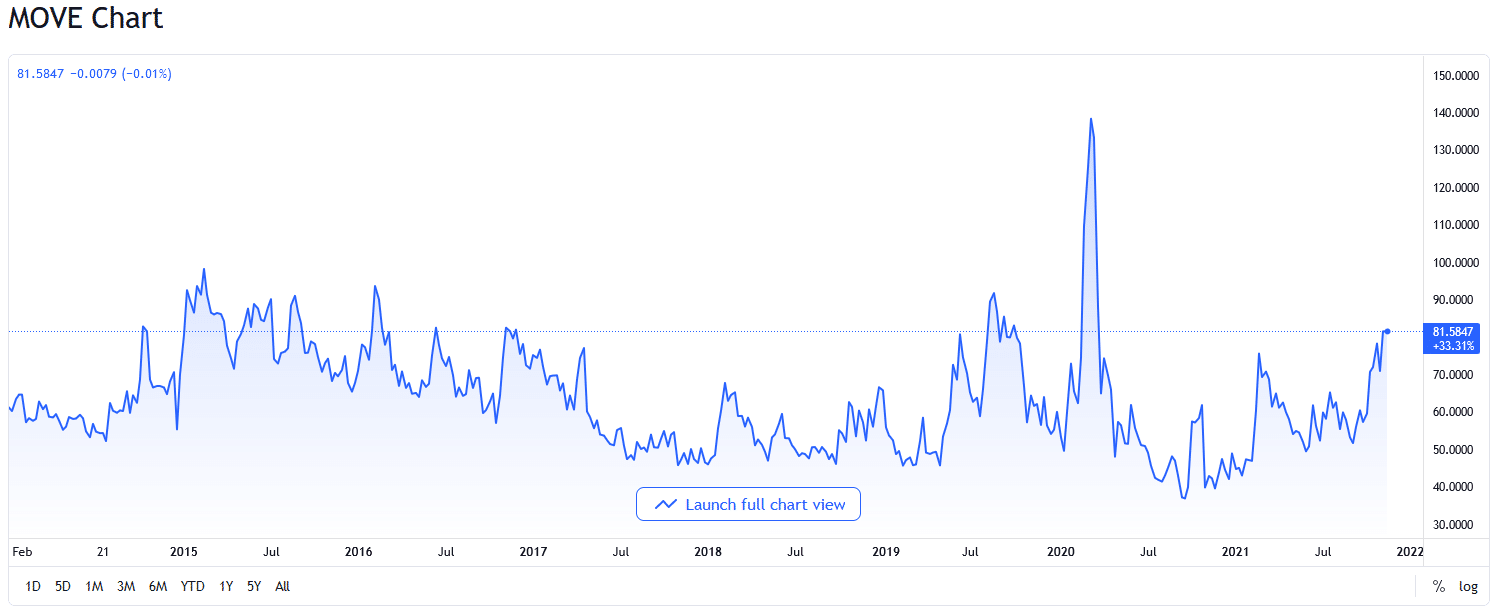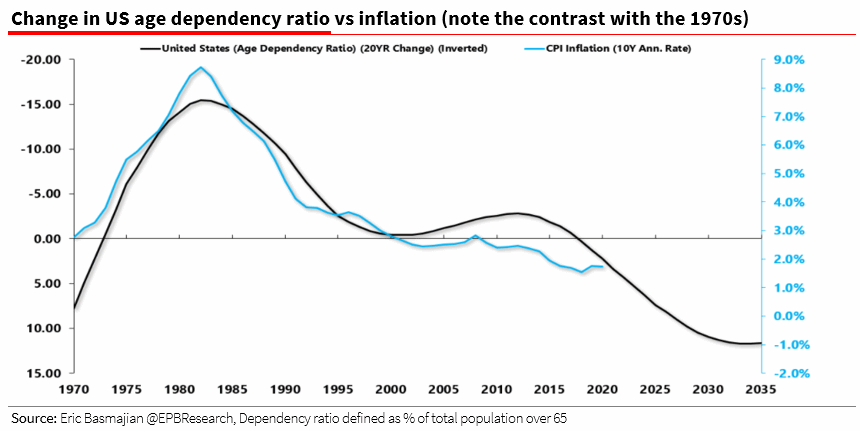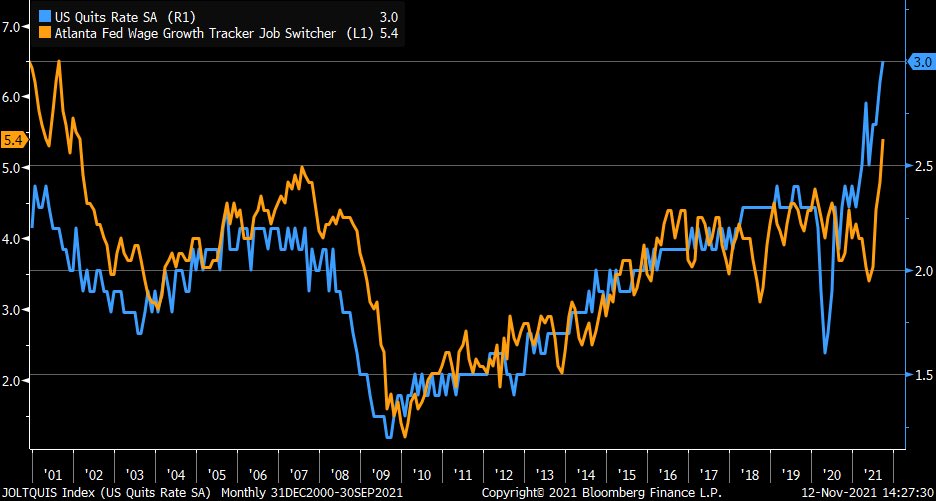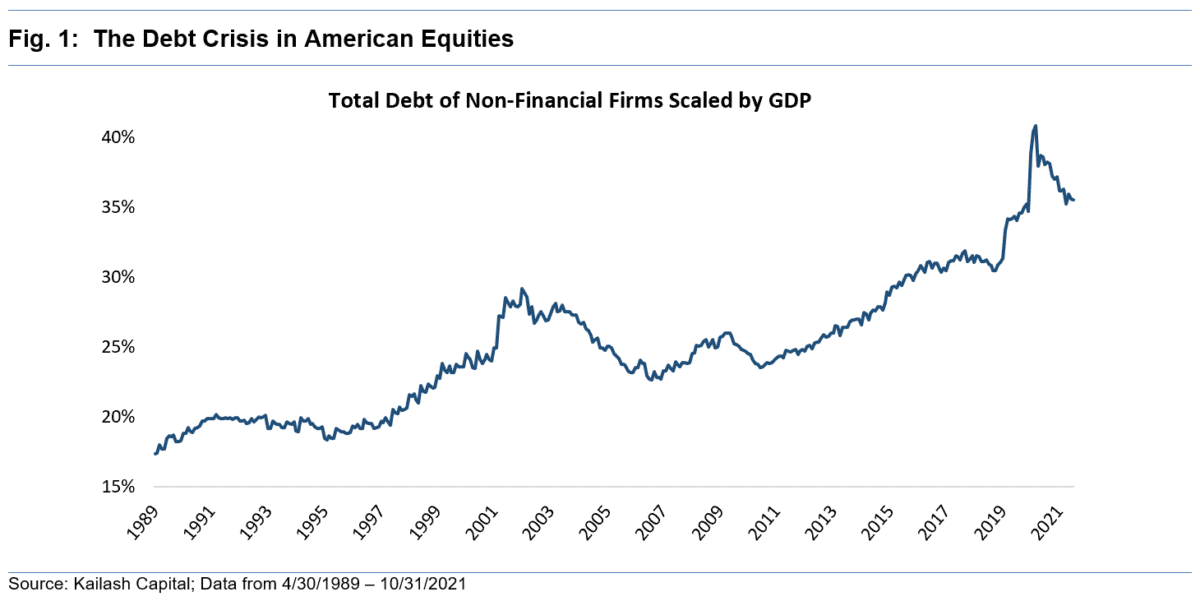Fed’s Williams says
“we must think about how to shore up the Treasury Market so it can better endure the next big shock.”
That “big shock” headline and similar comments from Fed President Loretta Mester make us wonder. Does the Fed foresee a big shock on the horizon that could destabilize the Treasury markets? The only apparent events we can think of are a quickened pace of tapering or the coming debt ceiling debate in Congress.
The bond market is also worrying about something. The graph below charts the MOVE index. The index measuring bond implied future volatility is similar to the VIX index measuring equity volatility. Currently, it is on the rise and near the peaks of the last five years, excluding the spike in March 2020.

Today
Post-market
- 4:00 p.m. ET: Applied Materials (NASDAQ:AMAT) to report adjusted earnings of $1.96 per share of $6.35 billion
- 4:00 p.m. ET: Intuit (NASDAQ:INTU) to report adjusted earnings of 97 cents on revenue of $1.82 billion
- 4:00 p.m. ET: Workday (NASDAQ:WDAY) to report adjusted earnings of 87 cents on revenue of $1.31 billion
- 4:05 p.m. ET: Palo Alto Networks (NASDAQ:PANW) to report adjusted earnings of $1.57 on revenue of $1.21 billion
- 4:15 p.m. ET: Williams-Sonoma (NYSE:WSM) to report adjusted earnings of $3.10 on revenue of $1.98 billion
What does The Fed Know?
- Fed’s Mester Says Improving Treasury-Market Resilience Is Top Priority
- Fed’s Williams says: “We Must Think About How To Shore Up The Treasury Market So It Can Better Endure The Next Big Shock “
The Next Financial Crisis – Problem With Expensive Stocks And High Leverage
A recent analysis from Kailash Concepts explains the problem of overvalued stocks and high leverage.
“We don’t understand why others are not alarmed by an ‘anything goes’ attitude towards record levels of leverage where interest expense cannot be paid for by profits. As documented in our brief post, Stocks vs. Bonds, the world is awash in financial alchemy.
"Since 2007, a big part of America’s debt crisis has moved from the financial sector to non-financial stocks with too much debt. KCR’s research team believes that the mix of record debt and record equity valuations is likely a side effect of real rates approaching the record lows last seen in 1973. Whether we are right or wrong on the causality, the facts are intimidating in our view.
"Our research has documented that the world has never been less prepared or less equipped to deal with a possible outbreak of inflation or pull-back in Federal largess.
"Figure 1 below shows the growth in total debt of non-financial firms as a percent of GDP. Financial repression and low rates have led to an explosion in borrowed money. Corporate America has never owed this much.”
Powell Or Brainard?
President Joseph Biden says he will choose the next Fed Chair in the coming days. The market is betting that Powell gets renominated, but some believe Lael Brainard has a chance. “Who Will Be The Next Fed Chair?“ a Baron’s article, compares and contrasts the two candidates. While they certainly have differences, Brainard is likely to be equally as dovish as Powell if she gets the nomination. However, the markets may be uncomfortable with Brainard. To wit, Danielle DiMartino Booth is quoted in the article as follows:
“Moreover, a shift away from the continuity at the Fed that Powell represents would like roil the markets, which is the last thing Biden needs now, she adds in an interview.”
Stocks Or Bonds?
Deflation Remains A Bigger Threat
Most Central Banks are increasingly convinced high inflation rates might not be so transient after all. Which is why the tightening cycle has now begun. It’s worth reminding oneself that secular demographics are set to reach maximum deflationary pressure in the decade ahead. This is in stark contrast to the 1970s when demographic trends underpinned the then inflationary surge.
But amid the current inflation panic, Eric Basmajian of @EPBResearch reminds us that the demographic headwinds facing the major economies are intensifying (especially with people dropping out of the workforce). His great charts show deflation pressures are intense. – link.
In the long-term, demographics will be a big shock to Central Banks' hopes of higher inflation rates.

7% Risk-free Yields
Mark Hulbert from MarketWatch shares a little-known secret about earning 7% yields in U.S. Treasury securities. In his article, Hidden In Plain Sight Is A U.S. Treasury Yielding More Than 7%, Mark walks through Treasury I bonds and the benefits of owning them in a higher inflation environment such as today. With the 6.2% inflation, the new coupon rate on I-bonds is 7.12% for the next six months.
Because I-bonds reflect the current inflation rate, they are a viable alternative to TIPs. As a comparison, the real yield (nominal yield less expected inflation rates) on the 5-year Treasury note is -1.66%. The graph below compares nominal yields for I-bonds versus the Treasury curve.

Job Quitters Are Driving Up Wages
The Job Quit rate is up to 3%, the highest level since they started tracking it 20 years ago. People typically “quit” or voluntarily leave jobs in search of higher-paying jobs. The graph below confirms a strong correlation between the quit rate and wages for those switching jobs. Given the record number of job quitters, we suspect wages will continue higher, putting further pressure on corporate profit margins and, more importantly, increasing the risk of a wage-price inflation spiral.


